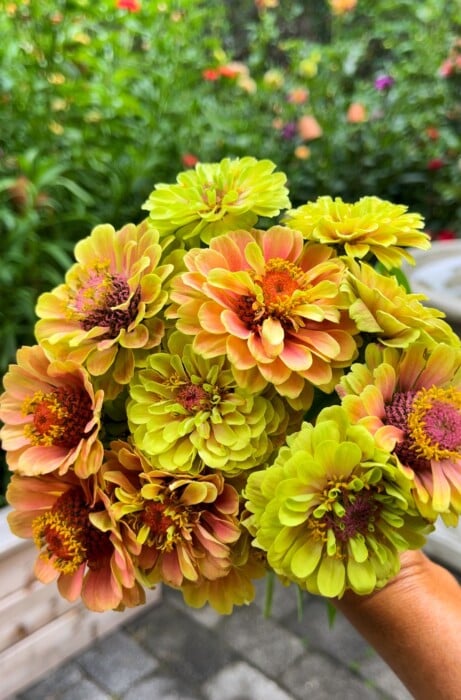No grow lights necessary! Learn the easiest way to grow sweet peas from seed using the winter sowing method.
As an avid gardener in Zone 6b New Jersey, I’ve spent years experimenting with different ways to grow my favorite flowers, especially sweet peas. I used to be all about starting seeds indoors under grow lights, meticulously tending to tiny seedlings and fretting over hardening them off. (You can read all about that process in my post, “How to Start Seeds Indoors Without a Greenhouse.”)
But honestly? It was a lot of work, took up precious space, and sometimes, despite my best efforts, those pampered seedlings didn’t always thrive once I transplanted them. That’s why I switched to winter sowing, and have not looked back! This simple, hands-off method has completely transformed how I grow sweet peas (and many other flowers, too!). Now, winter sowing is the only way I start these pretty flowers from seed. Here’s how to do it!
(Posts on stacyling.com may contain affiliate links. Click HERE for full disclosure.)

Getting to Know Sweet Peas
Sweet peas (Lathyrus odoratus) are a beloved garden classic, prized for their vibrant colors, delicate beauty, and intoxicating fragrance. These charming climbers add a touch of romance and old-fashioned charm to any garden. Here’s what makes them so special.
They are typically grown as annuals, meaning they complete their life cycle in one growing season. However, in mild climates (Zones 7-10), they may sometimes overwinter and behave as short-lived perennials. Unfortunately for me, my New Jersey climate is a bit too cold for them, so I need to start them from seeds every year.
- Hardiness Zone: Sweet peas thrive in cool-season climates and are generally hardy in Zones 3-10.
- Light: They prefer full sun (at least 6-8 hours per day) but appreciate some afternoon shade in hot climates.
- Soil: Sweet peas prefer fertile, well-drained soil with a slightly alkaline pH (around 7.0).
- Bloom Time: Sweet peas typically bloom in late spring to early summer. Winter sowing can help you achieve earlier blooms.
- Deer Resistance: Sweet peas are generally considered deer-resistant, but hungry deer may still nibble on them if other food sources are scarce.

Why Winter Sowing Rocks My Garden
Here’s why I’m such a convert to winter sowing sweet peas:
- Saves Time and Space: No more fussing with grow lights, heating mats, or finding space indoors for trays of seedlings. I just sow my seeds in mini greenhouses (more on those later!) and let Mother Nature do her thing.
- No Hardening Off Hassles: Winter sowing naturally hardens off seedlings, so they’re already tough and ready to go when it’s time to plant them out. No more transplant shock or losses!
- Stronger, Healthier Plants: I’ve noticed that my winter-sown sweet peas develop incredibly robust root systems and seem to be more resilient to pests and diseases. They just seem happier overall!
- It’s So Easy! Seriously, it’s almost foolproof. Even if you’re a beginner gardener, you can have success with winter sowing.
I’ve started sweet peas indoors before under grow lights and while they germinated and performed okay, they did far better winter sowing them. If you’ve had the same experience, I highly recommend starting your sweet pea seeds this way.
Supplies
- recycled clear plastic containers
- organic potting soil mix
- sweet pea seeds


Winter Sowing Sweet Peas: A Step-by-Step Guide
Ready to give it a try? Here’s how I winter sow them:
- Gather Your Supplies: You’ll need recycled clear plastic containers (like milk jugs or clamshell containers), a good quality seed-starting mix, and of course, your sweet pea seeds.
- Prepare Your Containers: Clean your containers thoroughly and poke drainage holes in the bottom.
- Prepare Your Sweet Pea Seeds: It’s a good idea to soak your sweet pea seeds for 24 hours before planting them to aid in their germination.
- Fill with Soil: Fill the containers with pre-moistened seed-starting mix, leaving about an inch of space at the top.
- Sow Your Seeds: Sow sweet pea seeds about ½ inch deep. I usually plant a few seeds per container.
- Label and Water: Label your containers with the variety of sweet pea and the date sown. Water the containers thoroughly.
- Create Mini Greenhouses: If using milk jugs, cut the jug almost all the way around, leaving a hinge on one side. For clamshells, use clear packing tape to secure the lid.
- Place Outdoors: Place your mini greenhouses in a sunny location where they’ll be exposed to the elements.
- Wait and Watch: Let Mother Nature do her thing! The fluctuating temperatures and natural precipitation will help the seeds germinate and grow.
- Transplant in Spring: Once the danger of frost has passed and your seedlings are a few inches tall, transplant them into your garden.
Because sweet peas are cold-tolerant, I usually plant them a little earlier than my last frost date to give them a head start. In full transparency, I watch the weather like a hawk and if a hard freeze is expected, I cover them with the clear domes to keep them protected.



My Simple Winter Sowing Setup
You can learn even more about how to make mini recycled greenhouses and what to do with them in my post, “How to Winter Sow Seeds Outdoors” The fluctuating temperatures and natural precipitation do the rest, and by spring, I have sturdy little sweet pea seedlings ready to be transplanted into my garden.
Zone 6b and Beyond: Is Winter Sowing Right for You?
If you live in a climate with cold winters and a defined frost period, winter sowing is definitely worth a try. It’s particularly well-suited for Zones 3-7, but even gardeners in warmer zones can adapt the technique for early spring sowing. While starting seeds indoors works, I’ve found that winter sowing produces stronger, healthier sweet peas in my Zone 6b garden.

Growing Sweet Peas: Tips for Success
Once your winter-sown sweet peas are ready to be transplanted, it’s time to give them the best possible start in your garden. Here are a few tips to help your sweet peas thrive:
- Sunlight: Sweet peas need full sun. Choose a location that receives at least 6-8 hours of direct sunlight per day.
- Soil: Well-drained soil is essential. Amend your soil with compost to improve drainage and fertility. Sweet peas prefer a slightly alkaline soil pH (around 7.0).
- Support: Sweet peas are climbers, so provide them with a strong trellis, netting, or other support structure to climb on. This will help them grow strong and produce abundant blooms. I usually grow mine up the fence in the potager garden, but there are other ways you can support the vines.
- Watering: Keep the soil consistently moist, especially during dry periods. Water deeply at the base of the plants to avoid wetting the foliage, which can encourage fungal diseases. For best watering practices, read more in my quick start guide.
- Fertilizing: Feed your sweet peas regularly with a balanced fertilizer to encourage healthy growth and flowering. I usually use this slow-release fertilizer so it’s set and forget.
- Deadheading: Remove faded blooms regularly to promote continuous flowering and prevent the plants from setting seed. To learn more about how to deadhead flowers, read this post.
- Pest and Disease Control: Keep an eye out for pests like aphids and slugs. Treat any infestations promptly. Also, be mindful of fungal diseases, especially in humid conditions. It’s really important to know what you are treating before you apply anything. Check out this post where I share organic alternatives for pest and disease control in your flower garden.
By following these tips, you’ll be well on your way to enjoying a beautiful and fragrant display of sweet peas in your garden.

Favorite Sweet Pea Flower Varieties
- Enchante
- Streamer’s Chocolate
- Elegance
- Royal Wedding
- Blue Ripple
- Midnight
- Old Times

Ready to Ditch the Grow Lights and Embrace Winter Sowing?
Give it a shot! You might be surprised at how easy and effective this method is for starting sweet pea seeds. I’m confident you’ll fall in love with winter sowing just like I did. Happy gardening!
For more information about starting sweet peas from seed, see this post from the North Carolina State Extension Service.
P.S. Want to learn more? Check out these helpful resources:
- Read more of my Winter Sowing Guide here
- Want to start sweet peas indoors? Read my comprehensive article here about how to start seeds under grow lights anywhere in your home.
To drill down on more beginner gardening techniques and tips, please read these posts:
- Flower Gardening 101
- Growing a Cut Flower Garden for Beginners
- Container Garden Ideas for Beginners
- How to Start a Vegetable Garden
- Herb Gardening for Beginners
Thank you for visiting the blog today!
Enjoy your day! xo







